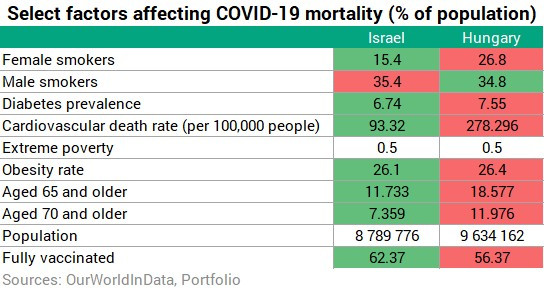Israel vs. Hungary – Act 2, Scene 1 (SPOILER ALERT: It's about the coronavirus pandemic)

A (slightly) poetic prologue
You have a few options when facing an unfamiliar problem or danger: (i) ignore it, (ii) run away (if you can), or (iii) take it on (especially when you have no choice). Sometimes you are apt (strong, smart, fast) and overcome on your own. Other times you find yourself to be inept (weak, dumb, slow). In the latter case it is best to observe those in the former group and learn from them. When it comes to the management of the coronavirus pandemic Hungary appears to be a stout member of the second group with little or no inclination to learn from the mistakes and/or successes of others.
We have already put the spotlight on Israel, pointing out how differently it has been managing the coronavirus pandemic than Hungary and what were the results of their respective approaches (read more by clicking the link below).
Here’s the most important indicator: deaths per one million population. Hungary is second in the world with 3,121, while Israel is 80th with 755. We can analyse all kinds of factors, but it boils down to this: how many people have died of coronavirus-related diseases since the outbreak last spring?
Hungary: 30,057. Israel: 7,043.
Still want to see some other factors? No problemo.

In Israel’s footsteps, only not in a good way
The chart below attests that Hungary has a two-month ’leeway’ relative to Israel when it comes to changes in the number of new confirmed daily COVID-19 cases. In the first wave Hungary fared a lot better, as an immediate full lockdown supressed the pandemic almost totally. There were extremely few cases and very few deaths. In the second wave, the peak of the daily infections was still lower (around 7,000) than in Israel (9,000), albeit the number of tests performed differed drastically. The third waves were almost identical in this respect, while the fourth…
Well, it’s nasty. More than 11,000 new cases per day reported on 30 August and over 12,000 reported on 28 August. In the meantime, Hungary reported 521 new cases for a three-day period, i.e. 174 per day on the same days.

The fourth wave in Israel started in mid-July and if the previous pattern remains, there a significant increase in daily COVID-19 numbers should start in Hungary in two or three weeks at the latest. And even if we forget about this pattern for a minute, there are factors we cannot ignore:
- there are practically no pandemic-related restrictions in place (more about this below);
- there have been various mass events with tens of thousands in attendance without masks;
- more of such events will take place within the next few weeks;
- school has started on 1 Sept, with only 14% of the 12-18 age group vaccinated against COVID-19;
- the government has no plans to (re)-introduce lockdown measures;
- not even mandatory mask-wearing is contemplated, even in indoor establishments;
- the Delta variant is more contagious than the previous strains;
- protection wears off with time whether it was gained via inoculation or infection;
- Israel used and still uses only Pfizer-BioNTech’s COVID-19 vaccine. Hungary also used and still does China’s Sinopharm vaccine, the efficacy of which in the 60+ age group was put into question in numerous countries. Most of elderly people in Hungary had received Sinopharm (we’re talking about more than one million doses administered);
- 14% of school children in the 12-18 age group have been vaccinated against COVID-19. The government organised a vaccination campaign for them for the last two days of August (with Comirnaty), while being aware that full immunity builds up only 10-14 days after the second dose;
- more than 3.5 million people remain unvaccinated, and the cabinet does little to change their mind (no incentives offered, no restrictions for those without immunity certificates).
Hospital patients in focus
As regards people treated in hospital with coronavirus infection, Hungary also tracked Israel with a two to three-month delay. The chart below does not do justice to this observation, though, due to the immense gap between the numbers (the Israeli curve is a lot flatter). This also has to do with the extremely poor testing practices in Hungary, which had resulted in a lot more infections than depicted on the previous chart (i.e. Hungarian authorities chalked up only those with fairly serious symptoms).
When the number of hospital patients started to drop in Israel in October 2020, Hungary experienced a surge. A rise starting in Israel in mid-December took place simultaneously with a decline in Hungary. In mid-February, the number of COVID-19 patients in hospitals started to rise in Hungary and ebb in Israel (which lasted until end-July, early August). By the end of June, Hungary had around 100 people with coronavirus infection in hospitals.

What is absolutely bonkers is that while the patterns of the big waves largely match, the daily statistics look as if the two countries were on different planets. Israel has been reporting a steady rise in new daily cases AND in the number of hospital patients, while Hungary’s daily cases keep rising slowly BUT the number of COVID-19 patients in hospital hovers between 70 and 90 (or 100). What is that, seriously? It must have to do with testing, right?
As the big waves move in tandem (with a two-month delay in Hungary) we should expect a surge in the number of hospital patients in Hungary too. Especially if we look at the big picture, the total length of the pandemic so far, and the aforementioned current conditions in terms of pandemic defense measures.
As you can see on the chart below, Israel had way fewer people in hospital even at the peaks of the waves than Hungary. On its worst days it had about 2,200 COVID-19 patients in hospital, while Hungary had over 12,000. We’d love to tell you about the differences in ICU admissions, but Hungary does not disclose such data, only the number of patients on ventilators.
In late August, Israel reported 8,500 new daily cases and 1,400 people with COVID-19 in hospital. Hungary reported 180 cases with 93 people in hospital.
The long-term patterns are similar, but the recent changes…, well, let the charts speak for themselves.


Vaccination practices: Sprinter vs. long-distance runner
Israel has been a trailblazer in the post-pandemic (?) world, largely returning to business-as-usual in May following one of the world’s most successful vaccination campaigns. It is now struggling with a surge of new COVID-19 cases, but is relentlessly trying to contain the fast-spreading wave of infections, keeping up its vaccination rate high. (It has administered 2.267 million booster shots already.)
While Israel has about 12,000 new cases per day, it vaccinates 120,000 people against COVID-19, including third doses. In comparison, when Hungary had around 180 new cases, it administered about 5,000 shots.
Hungarian authorities did report over 14,000 vaccinations for the last two days, though, but the vaccination rate appears to be stuck around 60%. We see a clearly ascending trend in Israel and a descending one in Hungary since July, and particularly since August. And the two countries are not even in the same league.
The following four charts compare new daily COVID-19 cases and new daily vaccinations in two periods, between the start of vaccinations (20 Dec 2020 in Israel and 19 January 2021 in Hungary) and 31 August, and in a shorter period between 1 June and 31 August this year (bottom two).


How to manage a pandemic?
"You shall not pass!" vs. "I assure you, we’re open!"
There are a host of factors a country needs to take into consideration when deciding on lockdown measures, and the cost of human lives is sadly only one of those. The upper pair of the following charts show that both countries took the pandemic very seriously at first, although Israel scored higher on the Stringency Index right from the start.
Check out Portfolio’s analysis of the severity of lockdown measures in Europe at the top link below. This overview found that Hungary is one of the countries in Europe with the loosest measures in place to stem the spread of coronavirus, even though its COVID-19 statistics are still among the more favourable ones (although worsening).
Note that although the top of the Stringency Index charts for both Hungary and Israel is at 100, Hungary never went north of 80 (top score was hit at 79.63 in March this year), while Israel scored almost 95 in the first wave, over 85 in the second and over 87 in the third.

As regards the period between 1 June and 31 August, we can see that Israel did not hesitate much to tighten lockdown measures as the number of new COVID-19 cases started to pick up. Hungary, on the other hand, continues to hang loose, and government officials made it clear that the cabinet was not considering lockdown measures again. Hungary’s current score on the Stringency Index is 27.78, against Israel’s 45.37.

The difference between the scores of Hungary and Israel are shown on the chart below in the blue area (the negative values mark the extent by which Hungary’s lockdown measures are looser than those in place in Israel).

Masking the truth
The sub-heading should be followed by a revealing analysis on how testing and the artificial or at least well-delayed reduction / 'distributive management' of active COVID-19 cases can mask the true nature of the pandemic in Hungary, but that's a story for another time. Until then...
Why are we talking about the stringency of lockdown measures at all? Because the spread of coronavirus can be stemmed only in so many ways. Vaccines are, of course, effective, but even high vaccination rates are evidently no guarantee that infections will be kept in check, especially as the virus continues to mutate and new variants have so far proven to be more transmissible than their predecessors. (And let’s not even go into how deadly they could become or discuss post-Covid syndrom and long-term effects.)
Secondly, wearing face masks is a scientifically proven ‘weapon’ against contracting and spreading the virus. It’s easy AF. It does not cost big bucks to buy a good mask (N95, FFP2, KN95); it’s compact so you can carry it with you anywhere; if you go indoors or in a crowd you just put it on and, bibbidi-bobbidi-boo, you’re a LOT safer than without a mask.
Closing schools, plants, stores, various services, and introducing cerfew is whole different level of lockdown measures that do have economic consequences, but Hungary does not enforce even the simplest ones as mandatory mask-wearing at certain places that would not even scratch GDP growth at all.
Testing, testing, testing. Check one, two, three... Okay, good. Or is it?
Alright, let’s talk about testing. Phew, what a mess. At least in Hungary.
If it wasn’t so tragic, this would be the place to burst out laughing.
Just one random example:
30 August --- Israel: 11,000 new cases, 146,000 tests. Hungary: 110 cases, 5,618 tests.
To the untrained eye the chart below may tell a different story, as the curves appear to be at nearly the same height, but note that there’s a tenfold difference in the scales.

So here are two that show reality a bit clearer.


Parting words, a.k.a. conclusion
There’s no shame in losing to the best or even to the better. But there is shame in ignoring the methods, tactics, agility, ingenuity or just sheer resilience or common sense of the best, particularly when it is also taking heavy hits despite its best efforts.
And one more thing: please don’t wait for the government to set you straight! Just do your part, do your best not to get infected and, if you still do, not to transmit it. Masks, remember? It’s not a panacea but that’s the very least you can and should do. It’s easy AF.
Cover photo: Getty Images









